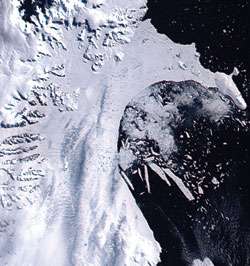October 25, 2011 report
Team says Arctic ice shelf broke up before

(PhysOrg.com) -- Arctic shelf ice has been in the news of late due to its shrinkage over the past few decades that most attribute to global warning. Thus, its levels and seemingly constant calving have become ecological barometers that environmentalists have come to use to show just how fast our planet is heating up.
Now however, new research by a team from Université Laval in Canada, led by Dermot Antoniadesa, have found, after studying sedimentary material on the bottom of the Disraeli Fiord, created by backup from an ice shelf in Northern Canada, that it experienced a major fracture that resulted in an overall reduction of the ice shelf some 1,400 years ago. Which means this isn’t the first time that the shelf ice has melted and broken apart. The team has published the results of its survey in the Proceedings of the National Academy of Sciences.
Shelf ice is a thick platform of ice that has been pushed out to sea by glacier pressure. As the sea level drops, the ice tends to float even as it’s still connected to the shore. Hence its name, it literally looks like a giant shelf hanging off the land out into the sea. One ice shelf in particular, Ward Hunt, located on Ellesmere Island, lies off the north central coast of Canada and is part of a group of ice shelves that once comprised most of the northwest coast of the Island. Over the past hundred years, the shelf ice in this region has diminished by nearly 90%.
Because ice shelves also act as dams, backing up water into fjords, sediments from them build up on the sea floor and in the spaces between the salty seawater and fresh water produced by melting ice. By analyzing these sediments using carbon 14 dating and other techniques, the researchers are able to create a record or timeline of sorts that they can use to look into the past. In this case, the research team found that the ice shelf first appeared approximately 4,000 years ago and hung around for several thousand years. But then about 1,400 years ago, a major fracturing occurred that caused the shelf to shrink. It didn’t fully recover until about 800 years ago. After that, it held steady till the shrinkage that began nearly a hundred years ago and continues to this day.
At this point, it doesn’t appear that the shelf ice around Ellesmere Island is any smaller now than it was during the previous period of warming, but because it’s still shrinking, it’s possible it could become, as Antoniadesa writes, an “unprecedented” event.
More information: Holocene dynamics of the Arctic's largest ice shelf, PNAS, Published online before print October 24, 2011, doi:10.1073/pnas.1106378108
Abstract
Ice shelves in the Arctic lost more than 90% of their total surface area during the 20th century and are continuing to disintegrate rapidly. The significance of these changes, however, is obscured by the poorly constrained ontogeny of Arctic ice shelves. Here we use the sedimentary record behind the largest remaining ice shelf in the Arctic, the Ward Hunt Ice Shelf (Ellesmere Island, Canada), to establish a long-term context in which to evaluate recent ice-shelf deterioration. Multiproxy analysis of sediment cores revealed pronounced biological and geochemical changes in Disraeli Fiord in response to the formation of the Ward Hunt Ice Shelf and its fluctuations through time. Our results show that the ice shelf was absent during the early Holocene and formed 4,000 years ago in response to climate cooling. Paleoecological data then indicate that the Ward Hunt Ice Shelf remained stable for almost three millennia before a major fracturing event that occurred ∼1,400 years ago. After reformation ∼800 years ago, freshwater was a constant feature of Disraeli Fiord until the catastrophic drainage of its epishelf lake in the early 21st century.
© 2011 PhysOrg.com



















